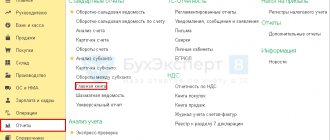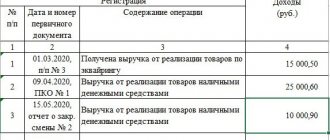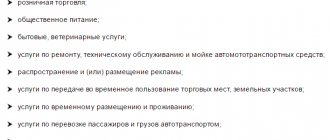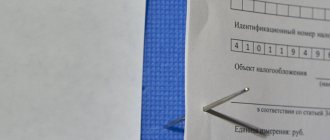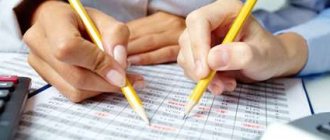Maintaining a book of income and expenses under the simplified tax system: rules and responsibilities
In accordance with Art.
346.24 of the Tax Code of the Russian Federation, all taxpayers who have chosen the simplified tax system must keep records of income received and expenses incurred in order to determine the object of taxation. For this purpose, a tax register is opened annually: a book of income and expenses. The form of this register and the rules (procedure) for its completion were approved by Order of the Ministry of Finance of Russia dated October 22, 2012 No. 135n (hereinafter referred to as the Procedure, Order No. 135n).
The book can be maintained in any way (filled out manually or on a computer), but in any case, its final copy must exist in paper form, have numbered sheets and be certified by the signature of the head of the legal entity or individual entrepreneur and a seal (if there is one).
The book does not need to be submitted to the Federal Tax Service along with the tax return, but during an audit it must be presented to the inspector within 10 days (clause 3 of Article 93 of the Tax Code of the Russian Federation).
If the book is not kept or there are significant violations when filling it out that lead to an underestimation of the taxable item, the violating taxpayer faces a fine. The maximum fine is 20% of the amount of the unified simplified tax system that has not been received into the treasury, the minimum is 40,000 rubles. (clause 3 of article 120 of the Tax Code of the Russian Federation).
If a violation of the tax accounting procedure does not lead to an understatement of tax, the fine for the taxpayer will be from 10,000 to 30,000 rubles (clauses 2 and 3 of Article 120 of the Tax Code of the Russian Federation). Failure to provide the book at the request of the inspectors will result in a fine of 200 rubles. (Article 126 of the Tax Code of the Russian Federation) plus 300–500 rubles. (Article 15.6 of the Administrative Code) in the form of an administrative penalty against the head of a legal entity.
Read more about liability for tax offenses committed in the article “Responsibility for tax offenses: grounds and amount of sanctions .
Features of the design of the income and expense journal
The income and expense accounting book is a journal consisting of a title page and five sections dedicated to decoding:
- income and expenses taken into account for taxation, which are broken down quarterly and contain information on data generated on an accrual basis;
- expenses related to fixed assets and intangible assets, taken into account for the purposes of calculating tax during the tax period, highlighting in them data corresponding to the number of quarters of operation in this period;
- amounts of losses from previous years that may reduce the tax base;
- expenses taken into account to reduce the amount of accrued tax for payers of the simplified tax system who have chosen income as the object of taxation, with a quarterly breakdown of this data;
- amounts of trade tax by which tax is reduced under the simplified tax system for the object “income”.
For an individual entrepreneur who has chosen “income minus expenses” as the object of calculation of the simplified tax system, sections 1 and 2 are required to be completed. The 3rd section will be drawn up by him if there is data on the loss received in previous tax periods. The 4th and 5th sections have nothing to do with the object “income minus expenses”.
If the object “income” is selected for calculating the simplified tax system, then you will have to fill out the 1st section regarding income and the 4th section. Sections 2 and 3 will not be processed in this case. Section 5 is completed if there are amounts of trade duty that reduce the tax.
Each tax period (year) should have its own separate journal. Only data that is relevant to the calculation of tax should be entered into it. They are reflected in separate lines, observing the chronology of events and indicating links to the source data of the primary documents.
The journal can be generated not only on paper, but also in electronic form. In the latter case, it must be printed (not excluding unfilled sections) and, just like a book originally created in paper form, bound, the sheets numbered, certified with the signature of the individual entrepreneur and seal, if the individual entrepreneur has one. If there is no data to fill out, a properly executed journal must still be available to the individual entrepreneur.
For more information on maintaining KUDIR, see the articles:
- “Book of accounting of income and expenses under the simplified tax system in 2021 - 2019”;
- “How to keep a book of income and expenses under the simplified tax system (sample)?”
How to keep a book of income and expenses of an individual entrepreneur
The procedure for maintaining a book of income and expenses for individual entrepreneurs is no different from the general rules.
Entrepreneurs do not indicate in column 4 of Section I of the book income that is subject to personal income tax. This is directly stated in clause 2.4 of the Procedure approved by Order No. 135n.
In section IV of individual entrepreneurs on the simplified tax system, 6% without employees reflect the insurance premiums they transferred for themselves. Those who make payments to other individuals, in this column reflect both contributions transferred for themselves in a fixed amount, and similar payments paid for employees.
How to fill in by selecting the “income minus expenses” object
Those who pay tax on the difference between income and expenses fill out all sections of the book, as well as a certificate for section I.
When filling out Section I, please provide the following information:
- in column 1 - the serial number of the registered transaction;
- in column 2 - the date and number of the primary document on the basis of which the income was received or the expense was made;
- in column 3 – the content of the registered transaction;
- in column 4 - income taken into account when calculating the single tax;
- in column 5 - expenses taken into account when calculating the single tax.
- in line 010 - the amount of income received for the year. It can be viewed in the line “Total for the year”, column 4 of section I of the book of accounting for income and expenses;
- in line 020 - the amount of expenses for the year. It is equal to the indicator in the line “Total for the year” in column 5 of section I;
- in line 030 - the amount that can be obtained if you subtract from the amount of the minimum tax that was paid the amount of tax calculated in the general manner;
- in line 040 - the total amount of income. You will get it if you subtract the indicators of lines 020 and 030 from the indicator of line 010;
- in line 041 – the total amount of losses. You will get it if you subtract the sum of line 010 from the sum of lines 020 and 030. Do not indicate a negative value.
How to keep a book of income and expenses in electronic format
Most official portals with regulatory documents offer to download a file in MS Excel format for maintaining the register in electronic form. When you download it, an electronic document opens in the form of a formatted appendix to order No. 135n.
Due to the fact that the procedure for maintaining a book in electronic and paper formats is the same, there should not be any particular difficulties with its design on a computer. If an error made when registering a transaction was discovered before the book was printed on paper, it can be easily corrected. If an error was discovered when the register was printed, the correction is made on the basis of clause 1.6 of the Procedure (certified by the manager’s signature and seal (if any) with the date of the correction).
The register, which was kept in electronic format during the year, must be printed at the end of the tax period. Its sheets are numbered, stitched and sealed with the signature of the head - a legal entity or individual entrepreneur - and a seal (if any).
Sending the book to the Federal Tax Service in electronic format with a digital signature is not provided for by the specified Procedure.
Is it possible to change the method of maintaining KUDiR (from electronic to paper or vice versa) during the year? The Ministry of Finance of the Russian Federation answered this question. Get trial online access to K+ for free and proceed to the explanations of the officials.
How to fill out sections of the income and expense ledger
Each business transaction performed by a taxpayer using the simplified tax system during the tax period, which has an impact on the formation of the tax base, must be registered in the book. Entries are made in chronological order. Based on the results of each quarter and at the end of the year, results are compiled.
ConsultantPlus experts provided a detailed commentary on filling out the book of income and expenses, including samples of completion. Get trial online access to K+ for free and proceed to recommendations.
Column 4 of Section I reflects income, the list of which is contained in Art. 249–250 Tax Code of the Russian Federation. Accordingly, the operations listed in Art. 251 of the Tax Code of the Russian Federation, as well as those that are subject to income tax for legal entities or personal income tax for individual entrepreneurs. Income received in kind is reflected at the market price of the received property.
Taxpayers who have chosen the accounting object “income minus expenses” enter their expenses in column 5 of the same section (their list is specified in Article 346.16 of the Tax Code of the Russian Federation). “Simplified people” who pay tax on the object “income” indicate in this column their expenses incurred as part of the implementation of budget unemployment programs, as well as expenses that were made from funds subsidized for the development of entrepreneurship.
Section II, concerning fixed assets, is filled out by simplifiers who have chosen “income minus expenses” as the object of taxation. Section III is also completed by taxpayers working with the “income minus expenses” object, if they have losses based on the results of previous years that can be taken into account when calculating the tax for the current year.
Section IV is filled out by taxpayers who calculate the single tax on the “income” object. All insurance premiums paid are recorded here, which have an impact on reducing the amount of accrued tax.
Since 2021, the book of income and expenses has been supplemented with Section V, in which taxpayers who have chosen “income” as the object of taxation reflect the amounts of trade duty paid, which affect the amount of tax payable to the budget.
For more information about the differences in the procedure for filling out the book, depending on the chosen object of taxation, read the material “The procedure for filling out KUDiR under the simplified tax system, income minus expenses .
You can download the current book of expenses and income form for 2020-2021 on our website.
If you use the tax object “income”, then see the sample KUDiR for 2021 in ConsultantPlus. If you have “income minus expenses,” then the sample for 2021 is at this link. It's free.
And if you need the previous version of the register (for 2013-2017), then this is it:
Features of filling out KUDiR on the simplified tax system
The form consists of 5 sections.
Section I “Income and Expenses”
All business transactions are entered into this part in chronological order, indicating:
- dates and numbers of the primary document (z-report, payment order, sales receipt, act, invoice, etc.);
- contents of the operation. For example, “Receipt of payment for goods shipped by Gamma LLC”;
- amounts.
If the operation is profitable, then the amount is entered in column 4, if it is expenditure, in column 5.
On the simplified tax system 6%, column 5 is not filled in.
You only need to record those amounts of income and expenses that are included in the tax calculation. For example, receipt and repayment of loans, payment of authorized capital, and contribution of own funds - all this is not considered taxable income, so there is no need to enter such transactions into KUDIR.
A complete list of income and expenses that affect the amount of tax is given in Articles 346.15 and 346.16 of the Tax Code of the Russian Federation, and the recognition procedure is in Article 346.17.
When to enter income
The simplified tax system uses the cash method, which means that all receipts are deposited into KUDiR at the moment the money is received in the current account or at the cash desk.
At what point should you enter expenses (only for simplified tax system 15%)
It all depends on the nature of the expenses.
- Material costs are incurred when the materials are both shipped and paid for. That is, the latest date will appear in KUDiR. If the materials have already been paid for, but not yet received, or vice versa, the amount of expenses is not yet included in taxation and an entry is not made in the KUDiR.
- Expenses for fixed assets (purchase, construction, manufacturing) and intangible assets are paid on the last day of the quarter based on calculations from Section II.
- Expenses for the purchase of goods intended for resale are paid only as they are sold. That is, the purchase price of goods that have not yet been sold and are in storage cannot be taken into account as tax expenses.
In the certificate at the end of section I on the simplified tax system 6%, fill out only line 010.
Based on the final data of KUDiR by quarter and year, advance payments and annual tax are calculated, and a tax return is filled out according to the simplified tax system.
Section II “Calculation of expenses for the acquisition of fixed assets and intangible assets”
This section is intended only for simplifiers with the “Income minus expenses” object.
Data is entered into it only for those fixed assets that have already been put into operation and only within the limits of paid amounts.
Costs must be distributed evenly across the quarters remaining until the end of the calendar year.
For example, if a fixed asset was purchased in February, that is, in the first quarter, for 200 thousand rubles, then the costs will be written off in 50 thousand increments on the last date of the first, second, third and fourth quarters. And if the purchase was made in July, that is, in the third quarter, for 300 thousand, then 150 thousand each must be written off in the third and fourth quarters. Expenses for OS purchased in the fourth quarter will be written off in one amount on the last date of the fourth quarter.
The calculated amount to be written off for the current quarter from column 12 of section II is entered into column 5 of section I on the last day of the quarter.
Columns 7, 8, 14 and 15 are intended for those cases where the fixed asset was purchased before the transition to the simplified taxation system.
Section III “Calculation of amounts of losses from previous periods that reduce the tax base”
This part is also intended only for those who apply the simplified tax system of 15%, had losses in previous periods and can reduce the tax base by the amount of these losses.
Section IV “Expenses that reduce the amount of tax”
This section is filled out by those who apply the simplified tax system of 6%.
It includes the amount of insurance premiums, sick leave paid at the expense of the employer, contributions for voluntary insurance of employees, i.e. those amounts by which the simplified tax system (USN) tax will then be reduced to 6%.
Section V “Calculation of amounts of trade duty that reduces tax”
This part is filled out by those who apply the simplified tax system “Income” and pay a trading fee.
Become a user of the “My Business” service, and you will not have to fill out the Income and Expense Account Book yourself. You will enter data on revenue and expenses, and the service itself will generate a KUDiR and tax return.
If all receipts and expenses go only through a current account, then creating a KUDiR in our service is even easier - you just need to upload a bank statement.
Our service will help you calculate taxes and contributions, report to regulatory authorities and pay taxes. The system accompanies all actions with step-by-step instructions and tips, so the chances of making mistakes are reduced to zero.
How to check the book of income and expenses in 1C
There is an opportunity to check the correctness of the book of income and expenses in the 1C: Accounting program. For this purpose, a special function “Book Filling Assistant” is provided. With its help, an accountant can run routine operations and analyze the results.
When you download the special service built into the program, you can view all accepted and non-accepted expenses. The most common mistake is the program’s failure to provide documents confirming payment of expenses incurred. And in the absence of payment, expenses cannot be taken into account (Article 346.17 of the Tax Code of the Russian Federation). You can correct the error by group re-posting all documents for the tax period.
Read about all the nuances of using this accounting program by simplifiers in the article “Using “1C Accounting” under the simplified tax system .
Settlement costs
The expenses incurred as a result of the offset of mutual claims should be reflected in the book of income and expenses as of the date of signing the act of offset of mutual claims. It is at the moment of signing the act of offsetting mutual claims that the organization extinguishes its obligation to the seller (Article 410 of the Civil Code of the Russian Federation). The date of expenditure on such operations is the date of termination of the obligation (clause 2 of Article 346.17 of the Tax Code of the Russian Federation). The basis for making entries in the book of income and expenses is the act of offsetting mutual claims.
Book of income and expenses: example of filling out in special situations
An example of filling out a book of income and expenses will help you avoid mistakes in its design. This is especially true in situations where some non-standard operation arises.
Example:
The taxpayer transferred the advance payment to the supplier using the simplified tax system, but he did not ship the goods to him, and in the end he returned the advance payment. In this situation, an entry in column 5 cannot be made when transferring the advance, since this type of expense is not specified in Art. 346.16 Tax Code of the Russian Federation. This means that the returned advance is not shown in column 4 “Income”. This is stated in the letter of the Ministry of Finance of Russia dated December 12, 2008 No. 03-11-04/2/195.
If the taxpayer receives an advance payment, this amount is reflected in income, since simplifiers are required to use the cash method. But when returning the advance payment, it is necessary to reverse the entry made earlier for the amount of the advance payment returned to the buyer.
A sample of filling out the book of income and expenses for 2019-2020 can be found on our website.
And this is a sample of filling out a book of income and expenses for periods up to 2018:
Income from payments with plastic cards
Situation: at what point should revenue be reflected in the income and expense ledger if customers pay with plastic cards? The organization applies simplification
The amount of revenue received when paying with plastic cards should be reflected at the time the money is received in the current account.
According to the general rules, those who use the simplified method determine income and expenses using the cash method (Article 346.17 of the Tax Code of the Russian Federation). The date of receipt of income under the cash method is the day:
- receipt of money into bank accounts (at the cash desk);
- obtaining other property (works, services, property rights);
- repaying debt to the organization in another way.
This procedure is provided for in paragraph 1 of Article 346.17 of the Tax Code of the Russian Federation.
When making payments using plastic cards, funds are credited to the seller's (performer's) bank account later than they are debited from the buyer's (customer's) card. Nevertheless, the income of the seller (performer) during simplification arises precisely at the moment the funds are received into the current account. On this date, the revenue that was credited to the account must be reflected in the book of income and expenses. Similar clarifications are contained in letters of the Ministry of Finance of Russia dated April 3, 2009 No. 03-11-06/2/58, dated November 21, 2007 No. 03-11-04/2/280, dated May 23, 2007 No. 03- 11-04/2/138.
An example of how sales proceeds are reflected in the book of income and expenses. The organization is engaged in retail trade and accepts plastic cards for payment.
The organization sells goods to the public through a network of retail stores. On April 12 of this year, two buyers presented plastic cards for payment (one purchased goods in the amount of 5,000 rubles, the other – in the amount of 10,000 rubles). The indicated amounts were credited to the bank account on April 14 and 15, respectively.
In column 4 of the book of income and expenses for the second quarter, the accountant reflected these amounts as they were received:
- April 14 – 5000 rub.;
- April 15 – 10,000 rub.
Results
Do not neglect filling out the book of income and expenses, because filling out this register is not difficult, and the consequences of its absence can be quite noticeable. and samples from our article and check yourself when filling out.
Sources:
- Tax Code of the Russian Federation
- Order of the Ministry of Finance of Russia dated October 22, 2012 No. 135n
- Code of Administrative Offenses of the Russian Federation
You can find more complete information on the topic in ConsultantPlus. Free trial access to the system for 2 days.
KUDiR - source of tax accounting data
Regardless of which tax regime the individual entrepreneur uses in his work, he does not have the obligation to maintain accounting records (subclause 1, clause 2 of Law No. 402-FZ dated December 6, 2011).
But at the same time, the individual entrepreneur must keep track of the data necessary to confirm the amount of income received and determine the base from which the tax payable will be calculated, i.e., he needs to keep tax records. For these purposes, the Tax Code of the Russian Federation provides for the preparation of a document such as a book of income and expenses (KUDiR). There are several types of this book intended for use under certain taxation regimes: OSNO, simplified tax system, unified agricultural tax, PSN. It is irrelevant only for UTII.
Both legal entities and individual entrepreneurs are required to maintain KUDiR under the simplified tax system under Art. 346.24 Tax Code of the Russian Federation. Moreover, the occurrence of this obligation does not depend on which taxable object the taxpayer chose to calculate the tax: “income” or “income minus expenses.”
The form of the book used under the simplified tax system and the rules for its design are approved by Order of the Ministry of Finance of Russia dated October 22, 2012 No. 135n (as amended on December 7, 2016).
